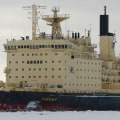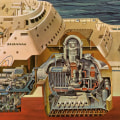As the world turns its attention to reducing greenhouse gas emissions from international air and maritime transport, nuclear-powered ships have become an increasingly attractive option. With their excellent safety record and the potential to reduce emissions, nuclear-powered vessels are gaining renewed interest. The first nuclear-powered merchant ship, the NS Savannah, was commissioned in 1964 and withdrawn from service in 1972. Since then, work on marine nuclear propulsion has continued, with the first test reactor launched in the United States in 1953. Today, the use of nuclear-powered ships is becoming more widespread. In China, for example, the China General Nuclear Power Corporation (CGN) has signed an agreement with the National Marine Petroleum Corporation of China (CNOOC) to provide energy for offshore oil and gas exploration and production.
This agreement is intended to “boost the organic integration of the offshore oil industry and the nuclear power industry”. The use of nuclear-powered ships also has a number of other benefits. For example, they can produce electrical energy with an efficiency of 36 percent from the fuel rod to the transmission line, which produces a total efficiency peak of 18 percent from the power plant through hydrogen and the fuel cell to the propeller. This means that arable land can be used for food production rather than cultivating crops to produce biofuel.
In addition, nuclear sailors have lower cancer mortality rates than the same age group in the general population. This is due to the fact that thousands and thousands of people have lived, worked, eaten and slept a stone's throw from these nuclear reactors for 60 years without any adverse effects of radiation. However, there are some drawbacks to using nuclear-powered ships. For example, they suffer specialized infrastructure costs due to their unique design and control panels that require modifications and improvements over time. While on the ship, it's customary for dosimeters to be in use to measure any nuclear contamination.
In addition, they are not allowed to transit through certain areas such as the Suez Canal without special permission from intergovernmental negotiation. Despite these drawbacks, nuclear-powered ships offer a number of benefits that make them an attractive option for reducing emissions and providing efficient energy production. As such, it is likely that interest in marine nuclear propulsion will continue to grow in the coming years.



